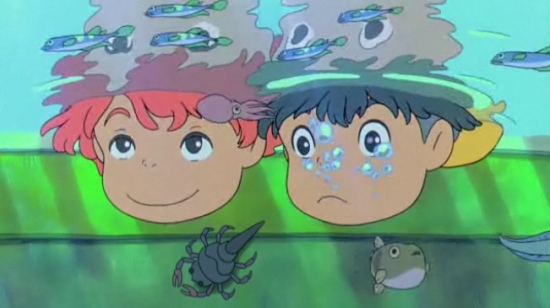Movie Review: Ponyo On The Cliff - Miyazaki Revives The Hand-Drawn Animated Epic
A fish girl falls in love with a human boy, and through a bit of magic she tries to become a human herself. It sounds like a typical fairy tale (and it's certainly not lacking in supernatural elements), but in the hands of the great Hayao Miyazaki, Ponyo on the Cliff is also grounded in reality as a moving tale of a hard-working mother and her young son dealing with an absentee father. It's filled with the visual splendor we've come to expect from a Miyazaki film, but it's the human elements that ultimately made the film work for me despite the lackadaisical narrative structure and diffuse plot.
The fish girl makes it to the surface, but is subsequently trapped in a glass bottle after escaping from a dredging ship. She's found by a young boy named Sosuke (Frankie Jonas), who believes her dead until she licks a drop of his blood. Instead of being freaked out by this like a sane person, Sosuke takes a liking to the fish girl and names her Ponyo.
Miyazaki has the unique capability of marrying every day life with the fantastical, so we're not surprised when no one really seems shocked that the fish Sosuke rescued has the face of a young girl. Eventually, Ponyo makes her way back to sea where she rebels against Fujimoto—who insists on calling her by her real name, Brynhildr. After she gains the ability to form human arms and legs, it's clear to Fujimoto she's much more powerful than he ever anticipated, and is a sign that he may soon have to get over his disdain for humans.
Of course, she escapes again, and the real meat of the story begins. The film is more about the journey for Ponyo (and eventually Sosuke), and is less concerned with plot than it is the dynamic between its characters. The bond between Sosuke and his mother Lisa (Tina Fey) is particularly well done. It's obvious that they both miss Sosuke's father, Koichi (Matt Damon), who is often away from home for fishing jobs, and you can tell that both have learned how to support each other in his absence. A scene where Sosuke and his mother communicate with Koichi while he's out at sea entirely with light signals and morse code is moving, original, and pure Miyazaki.
Much of what happens in the last act of the film seemingly comes out of nowhere, but again it's supported entirely by its characters. Despite the weak narrative, the film is gorgeously hand-drawn, with seemingly no reliance on CG compared to Miyazaki's more recent films. In an interview with Cut Magazine, executive producer Suzuki Toshio espoused why they're adhering to a hand-drawn look for Ponyo:
During this decade CG came up and we realized that it enables us to make expressions richer when using it as supplement of regular cel animation. On the other hand a new problem appeared. The progress of computing tech is so fast that it isn't easy to catch up. If a movie at one point is made by the highest tech, it will become outdated soon. There is one more point. We tried CG on Howl's. For example, the legs of the castle were made by CG. However, it didn't seem very natural to me and I told Miyazaki that his skill was better than that of a computer. He accepted it and quit using CG after that. Hence the latter half of Howl's doesn't include any CG. We now know CG has both its plus and minus sides. So the theme of this movie is as the story: simple. The visual effects are simple as well, while on the other hand it needs very hard working because of the drawing all it by hand.
I recommend that fans of traditional animation do their best to catch this film in theaters. It's truly a wonder to see traditional animation on the big screen again, and unlike Disney's upcoming Princess and the Frog, there aren't digital elements dancing around the screen either.
Ponyo on the Cliff also features yet another great score by Joe Hisaishi, Miyazaki's go-to guy since Nausicaa. It's suitably epic, and it even works in a variation on Ride of the Valkyries at one point. If you're a fan of any Hisaishi's previous work, you won't be disappointed.
I enjoyed Ponyo more than I did Miyazaki's last film, Howl's Moving Castle. Howl's felt like a lark for Miyazaki (it wasn't his original story), whereas Ponyo feels like he's flexing his muscles creatively. It's not nearly as deep as Princess Mononoke or Spirited Away, but it is a satisfying epic that will delight both children and adults alike. (Just make sure you run out before the horrendous Jonas/Cyrus song comes on during the credits.)
/Film Rating: 8 out of 10

